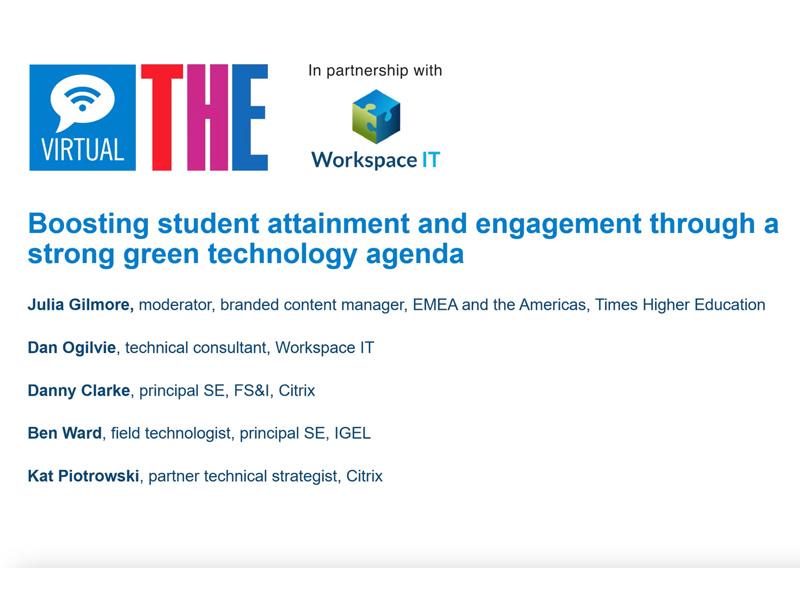Universities that invest in an environmentally friendly technology strategy can reduce their carbon footprint, save on energy costs and attract a generation of climate-conscious students.
At a recent Times Higher Education webinar, held in partnership with Workspace IT, a panel of industry experts discussed how institutions can boost student attainment and engagement through a strong green technology agenda.
Chair Julia Gilmore, branded content manager at Times Higher Education, said a university’s sustainability credentials were an increasingly important metric for students when choosing an institution to attend. With IT a major focus of the green agenda, she said universities had an opportunity to boost their sustainability credentials and save significant costs and time by repurposing hardware rather than replacing it.
A survey by the UK’s National Union of Students found that 91 per cent of students were concerned about climate change and 80 per cent wanted their university to do more for sustainable development.
Kat Piotrowski, partner technical strategist at Citrix, said prospective students wanted to know what different universities were doing to advance the green agenda before deciding where to study. “This is actually a big change that people are asking for. It’s not just, ‘how many windows is my dorm going to have? What is it going to be like on a student night out?’ It is, ‘I want to be part of a university that is going to be helping our planet moving forward’,” she said.
Ben Ward, field technologist and principal systems engineer at IGEL, said up to 83 per cent of a digital device’s total carbon footprint is generated during manufacturing, with raw materials procured from across the world. He suggested universities could save money and find favour with students by using devices beyond the “average refresh cycle of 3.8 years”.
“When students are looking at the university, give them the ability to choose an older device, potentially,” Ward said. “If you can say to them, ‘if you can love this device for another three or four years, you’re helping to save 353kg of CO2 which could be equivalent to several acres of trees’. That's the sort of message that we are seeing resonating.”
Dan Ogilvie, technical consultant at Workspace IT, said the company had devised a sustainability calculator for universities – and other organisations – to see the potential reduction in their carbon footprint and financial savings from switching to Cloud-based workspaces and virtual desktops.
“Just because a device is a bit old and not capable of running Windows 11, for example, certainly doesn't mean it should be destined for landfill. This is potentially a rare opportunity to have a positive impact on the environment and maybe save a bit of money,” Ogilvie said.
IT accounts for 10 per cent of all business electricity consumption, with 50 per cent of that impact driven by inefficiencies, said Danny Clarke, principal systems engineer for financial service and insurance at Citrix. He said universities should “shift emphasis from having workload on an end device” to an app or desktop virtualisation, efficient endpoints and the Cloud.
This approach would deliver “four pillars of sustainability in IT”, reducing power consumption, the impact of the device replacement cycle, emissions from travel and greenhouse gas emissions from data centres.
“Give [staff and students] flexibility and freedom to work or study from anywhere, reduce the travel, reduce the impact of devices because we’re no longer tied into a regular refresh. And reduce the impact of the data centre as well,” Clarke concluded.
The panel:
- Danny Clarke, principal systems engineer, financial service and insurance, Citrix
- Julia Gilmore, branded content manager, Times Higher Education (chair)
- Dan Ogilvie, technical consultant, Workspace IT
- Kat Piotrowski, partner technical strategist, Citrix
- Ben Ward, field technologist, principal systems engineer, IGEL
Watch the webinar on demand above or on the THE Connect YouTube channel.
Find out more about Workspace IT.
Find out more about IGEL.
Find out more about Citrix.


comment